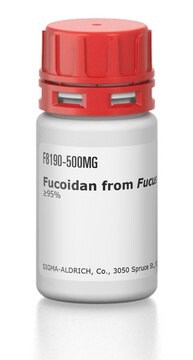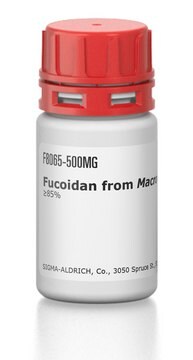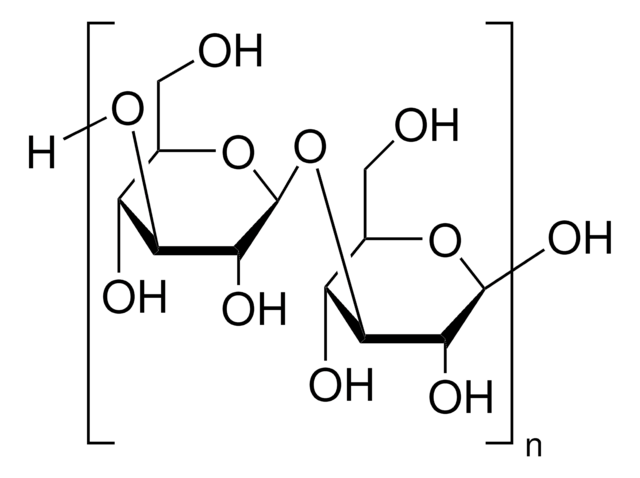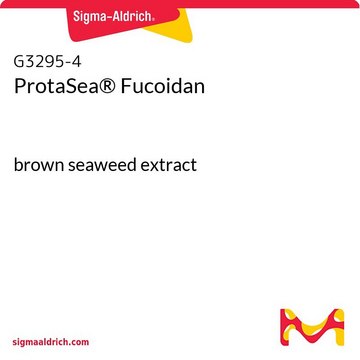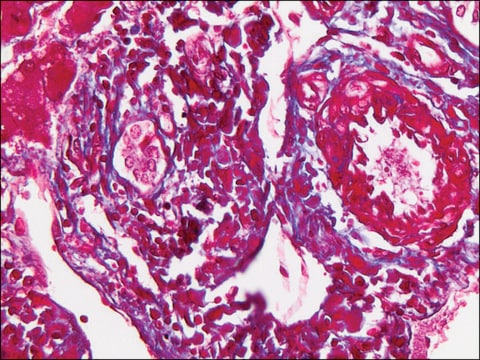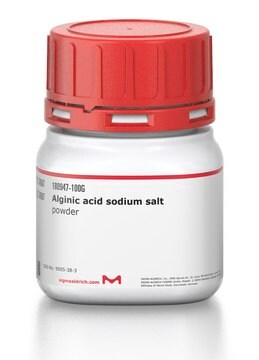F8315
Fucoidan from Undaria pinnatifida
≥95%
Zaloguj sięWyświetlanie cen organizacyjnych i kontraktowych
About This Item
Polecane produkty
pochodzenie biologiczne
algae (Undaria pinnatifida)
Poziom jakości
Próba
≥95%
Postać
powder
kolor
white to off-white
przydatny zakres pH
3.0 -7.0
rozpuszczalność
water: 10 mg/mL, clear to slightly hazy, colorless to faintly yellow
temp. przechowywania
room temp
Opis ogólny
Fucoidan has a complex chemical composition. It contains mannose, galactose, glucose, xylose and other monosaccharides. It is also composed of uronic acids, acetyl groups and protein.
Fucoidan is a fucose-rich, sulfated polysaccharide isolated from several species of brown seaweed.
Zastosowanie
Fucoidan from Undaria pinnatifida has been used to assess its antimicrobial potential in vitro.
Działania biochem./fizjol.
Studies of fucoidan have found it to have a broad variety of biological activities including antitumor and antiangogenic activities, immunomodulatory, anti-inflammatory, anticoagulant, antithrombotic, and antioxidant activities. Fucoidan induces macrophage activation which subsequently activates mitogen activated protein kinases (MAPKs) and results in natural killer cell proliferation. Fucoidan acts as a nonselective selectin blocker and has been shown to induce apoptosis and suppress angiogenesis.
Inne uwagi
To gain a comprehensive understanding of our extensive range of Polysaccharides for your research, we encourage you to visit our Carbohydrates Category page.
This page may contain text that has been machine translated.
Kod klasy składowania
11 - Combustible Solids
Klasa zagrożenia wodnego (WGK)
WGK 3
Temperatura zapłonu (°F)
Not applicable
Temperatura zapłonu (°C)
Not applicable
Certyfikaty analizy (CoA)
Poszukaj Certyfikaty analizy (CoA), wpisując numer partii/serii produktów. Numery serii i partii można znaleźć na etykiecie produktu po słowach „seria” lub „partia”.
Masz już ten produkt?
Dokumenty związane z niedawno zakupionymi produktami zostały zamieszczone w Bibliotece dokumentów.
Klienci oglądali również te produkty
Fucoidan: structure and bioactivity
Li B, et al.
Molecules (Basel), 13(8), 1671-1695 (2008)
Arumugam Ponnan et al.
Environmental science and pollution research international, 27(25), 31760-31766 (2020-06-07)
Fucoidan is a unique bioactive and dietary polymer enriched mainly in the cell wall matrix of the brown seaweeds. This present study was intended to reveal the antigenotoxicity effect of fucoidan on 4-nitroquinolin-1-oxide (4-NQO) induced genetics damage and apoptosis in
Anna Pielesz et al.
The Analyst, 140(13), 4599-4607 (2015-06-02)
Differential scanning calorimetry (DSC) and thermogravimetric (TGA) investigations, acetate electrophoresis (CAE), Fourier-transform infrared spectrometry (FTIR), scanning electron microscopy (SEM) analysis and microbiological procedures were all carried out after heating the samples to a temperature sufficient for simulating a burn incident.
Wentong Cui et al.
Laboratory investigation; a journal of technical methods and pathology, 94(4), 382-393 (2014-03-13)
Endothelial dysfunction, characterized by impairment of endothelial nitric oxide synthase (eNOS) and nitric oxide (NO) bioavailability, has been implicated in diabetic cardiovascular pathogenesis. In this study, low-molecular-weight fucoidan (LMWF), which has multiple biological activities including anti-inflammatory and anti-oxidative properties, was
Xiang Li et al.
Arteriosclerosis, thrombosis, and vascular biology, 34(8), 1661-1667 (2014-06-07)
Nuclear imaging of active plaques still remains challenging. Advanced atherosclerotic plaques have a strong expression of P-selectin by the endothelium overlying active atherosclerotic plaques, but not on the endothelium overlying inactive fibrous plaques. We proposed a new approach for noninvasive
Nasz zespół naukowców ma doświadczenie we wszystkich obszarach badań, w tym w naukach przyrodniczych, materiałoznawstwie, syntezie chemicznej, chromatografii, analityce i wielu innych dziedzinach.
Skontaktuj się z zespołem ds. pomocy technicznej